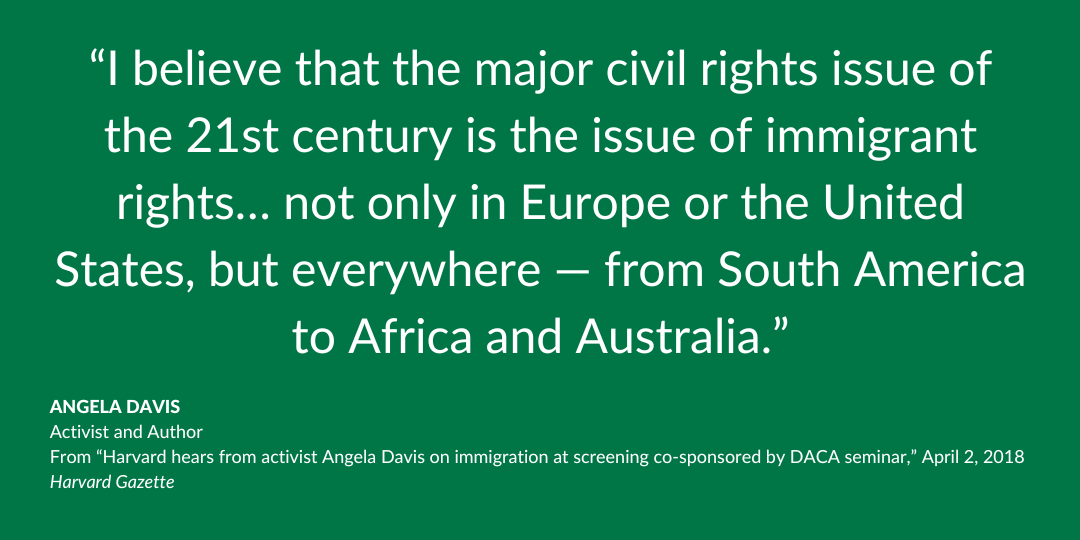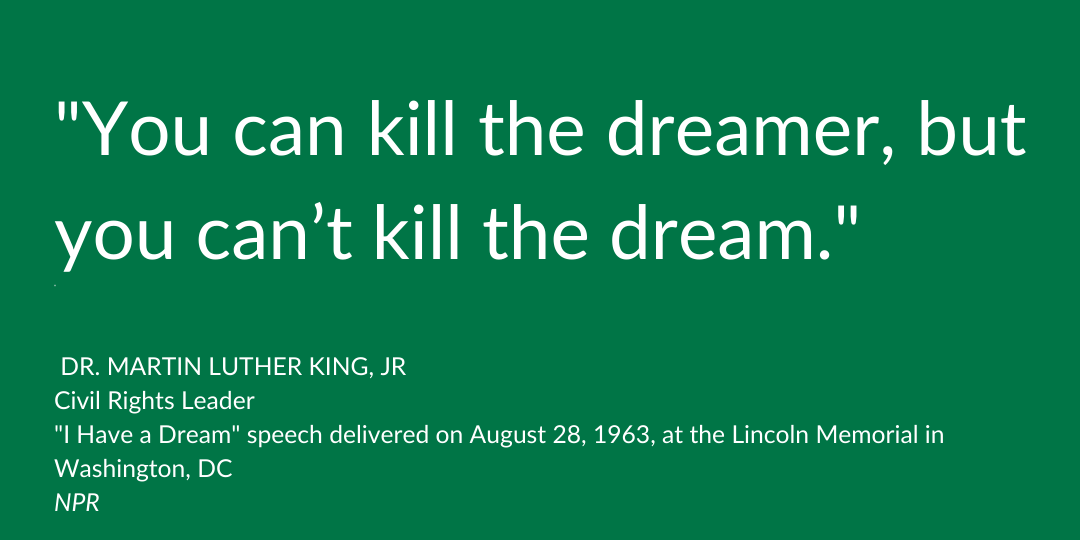It’s November already, can you believe it? In addition to colder temperatures and the end of daylight savings times (hello, darkness!), it’s also time for the most “American” of holidays—Thanksgiving. While the history of Thanksgiving is much more complicated than what is commonly taught in schools, it’s nevertheless an opportune time to reflect on our presence in this country as immigrants, refugees, and, yes, colonizers, and also reflect on how we have historically treated other immigrants and refugees. To that end, we are looking back at five major acts and cases in US history that have shaped and influenced US immigration law and policy.
Read moreSixty Years later, MLK Inspires Todays’ DREAMers
The 5 Biggest Immigration-Related Acts and Cases in US History
One Family
Somos 11 Millones/We Are 11 Million
Somos 11 Millones/We Are 11 Million by Andrea Bowers (with Movimiento Cosecha)
Los Angeles-based artist Andrea Bowers uses video, drawing, and installation pieces to combine art and activism in the struggle for social justice. For this piece on the High Line, Bowers collaborated with the immigrant rights activist group Movimiento Cosecha to write a slogan in support of DREAMers. The neon sign reading “Somos 11 Millones / We Are 11 Million” references the number of undocumented immigrants in the US. The piece is part of a group exhibition on the High Line that looks at the “power of art to change society, the role of art in public space, and whether art can be a form of protest.”
The Washington Post: “Justice Dept. to halt legal-advice program for immigrants in detention”
The Executive Office for Immigration Review (EOIR), an agency within the Department of Justice (DOJ) that adjudicates immigration cases and oversees the country’s immigration court system, has announced its intention to halt the Vera Institute of Justice’s Legal Orientation Program (LOP) while it audits the program’s cost-effectiveness. Vera’s LOP program offers legal educational services to detained immigrants. During the audit, the Trump administration will also evaluate the Vera Institute’s information “help desk,” which provides tips to immigrants who are not detained but still facing deportation. This announcement comes as DOJ attempts to deal with the massive backlog of approximately 650,000 immigration court cases by 2020. Earlier this month, the DOJ announced case quotas for immigration judges.
Read moreHuffington Post: “Supreme Court Foreshadows Big Constitutional Ruling In Immigration Case”
Last week the Supreme Court issued an unusual order in a pending immigration case that could foreshadow a key constitutional ruling and in doing so limit President-Elect Trump’s powers to detain certain noncitizens who may be eligible to be removed from the country. The ruling is in regards to a class-action challenge (Jennings v. Rodriguez) brought by the American Civil Liberties Union (ACLU) on behalf of thousands of immigrants, many of whom are in the US legally but who have been detained without an opportunity for a bond hearing in front of a judge to possibly obtain release. US federal law grants immigration authorities broad discretion to detain foreign-born individuals if they are apprehended at the border or have criminal backgrounds. The Supreme Court’s task in this case is to “determine what limits, if any, exist for that grant of authority.”
The justices appeared divided over how to rule, and the new order requests that lawyers for the federal government and the ACLU file a new round of legal briefs addressing whether the Constitution would require a “hearing in front of a judge―or even a release, if the government fails to present strong enough evidence that the person shouldn’t be released―if a detention lasted six months.” The lead plaintiff in the case is Alejandro Rodriguez who was detained for three years without a hearing even though he was a lawful permanent resident. He was facing removal over two minor offenses, a drug charge and joyriding as a teenager.
The ACLU explains the consequences of long-term detainment for noncitizens:
Without a bond hearing, people…may spend years behind bars in a prison jumpsuit, shackled for visits with loved ones, subjected to strip searches and solitary confinement, and referred to by guards as a number. They may suffer separation from family members, often across state lines; see their children placed in foster care; and lose jobs, savings, homes, and businesses. About 73 percent of immigration detainees are held in private prisons, which have a grisly track record of deaths due to medical neglect, suicides, and sexual abuse.
At the case’s oral arguments in November, the Supreme Court’s more conservative members appeared to be opting for a narrower ruling based on current immigration law and a prior appeals ruling in favor of the detainees. “We do not have the constitutional issue before us,” Justice Anthony Kennedy told Ahilan Arulanantham, the ACLU lawyer who argued the case. Justice Kennedy authored a concurring opinion in an earlier immigration case that upheld only brief detentions without due process.
With the additional request, the Huffington Post notes, the “justices may be signaling a desire to not split 4-to-4 in a case that could directly implicate the authority of the incoming Trump administration in an area that was a linchpin in the president-elect’s campaign.”
“I think it’s really hard to read the tea leaves here,” Arulanantham tells the Huffington Post. He adds that the justices’ request last Thursday indicates “the court wasn’t yet satisfied with either party’s position.”
One Family
"We can’t let people drive wedges between us because we are all one family...There is only one human race."
- Dolores Huerta, Labor leader and activist, honored recently with an exhibit on her life at the Smithsonian’s National Portrait Gallery
Why I’m Pro Pro Bono and You Should Be Too
Pro bono refers to work for the public good and in service to low-income clients. As legal professionals, our law licenses symbolize the economic monopoly we have over the provision of legal services. With that monopoly comes an obligation to ensure that those legal services are available to all who need them, and not just the select few that can afford to pay for them. There are few fields where this obligation is more important than in immigration law. Unlike criminal law, where a defendant has a constitutional right to be provided an attorney in the event that they cannot afford one, in immigration law–and most other areas of civil law–there is no right to free counsel. Over the last decade, there has been an increasing recognition of the need for a “civil Gideon” right (Gideon refers to the seminal Supreme Court case, Gideon v. Wainwright, that established the right to counsel in criminal proceedings)–the right to counsel for the poor in civil matters, including housing, family, and immigration law, among other areas of law.
Read moreMy Immigration Story
A series of posts by Daryanani & Bland staff sharing their own “immigration” stories—how they (or their families) came to America and/or how they came to work in the immigration law field.
My immigration story begins when I discovered my grandfather had an accent. As a child, I never recognized his Irish “brogue” (the word supposedly comes from the idea that the Irish sounded as if they spoke with a shoe in their mouths—“bróg” is the word for shoe in Irish), distinctive after more than fifty years of life in the US. I heard no difference at all in how he spoke compared to how my parents or grandmother (native “noo yawkahs”) spoke.
My grandfather was born in the Lanes of Limerick, Ireland in 1912. These same Lanes were made famous in Angela’s Ashes by Frank McCourt, and there has long been speculation in my family that the hearse driver mentioned in the book was my own great-grandfather. Who knows—people love a good yarn! Certainly Summer Street in Limerick—where my grandfather grew up—is a short walk from the home described in McCourt’s book. My grandfather had a 6th grade education but was among the most intellectual and well-read people I ever met. As a child during the Irish Civil War, he ran across enemy lines to deliver messages to the Irish Republican Army fighting the Provisional Government over the Anglo-Irish Treaty. Following the war—as before it—he and his family struggled to survive in the urban slums, and it was no surprise that he would follow in the footsteps of millions of his countrymen and women and take the boat to America. He arrived in New York City at age sixteen in 1928. His name was Jack Bray.
Read more



